Bus Takedowns

Part 1 of our Tubular Target Trilogy
A tubular target is a long and narrow, tunnel-like space we need to dominate, either to enforce the law, to rescue the helpless, or to just stay alive. Most of our tubular spaces involve travel: buses, trains, and commercial aircraft.
When we study the subject of bus takedowns, the first question we have to ask ourselves is: Why?
Why train for, or learn about, Tubular Target Takedowns?
- If you are in law enforcement, you may need to know how to take one back–without getting hostages, bystanders, or the driver killed. We’re presenting an “ideal” bus takedown here to help guide your planning, with the full knowledge that you will probably have less time and fewer resources should you actually need to recapture a bus full of people.
- If you are a bus driver, you may need to know what to expect should you and your passengers / students become hostages on a hijacked bus, so you don’t make the situation worse or get caught in a crossfire. And,
- If you are an armed (or unarmed but willing) citizen on public transportation when a 15:17 to Paris or a Long Island Railroad type shooting goes down, methods similar to those used by Air Marshals to dominate an aircraft cabin may serve you well.
This article will focus, in particular, on Bus Takedowns. We’ll discuss trains, planes, and automobiles in other posts.

Potential Bus Hostage Scenario
To set the stage for our discussion of bus takedowns, picture if you will the following hypothetical:
You are a school bus driver.
Two of the kids on your route recently moved into the area and started going to your school: fallout from a broken marriage. They’re both living with their mom now. Their father, either through his erratic behavior or substance abuse or whatever, has lost visitation rights. Maybe those same issues cost him his career. He doesn’t feel like he has much to live for, and begins contemplating various means of ending it all, including the increasingly popular “suicide by cop” option.
Then comes what we call a “precipitating event.”
Maybe one of the other kids on your bus lacks self control and touches the boobies of our Sad Sack former father’s little princess. Inappropriate and unacceptable, to be sure–but also not unheard of among kids.
Dad finds out about it somehow, arms up, and boards your bus as you are picking up kids after school.
Determined to teach that horny little punk a lesson, he threatens him with a pistol. But then, either through incompetence or anger or both (see Appendix II), he shoots the kid.
Even more desperate, now, he points the gun at you and orders you to drive.
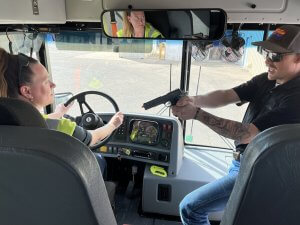
As you wonder what to do next, it will help if your decision is informed by what to expect from the police response.
Bus Hostage Rescue 101
Obviously, how we take down a long-haul (Greyhound type) bus varies slightly from how we takedown a school bus, a prison bus with metal screens over the windows, a city bus with advertising blocking the view in, or an airport shuttle van with darkly tinted windows. All of the above have different heights, shapes, and doors.

Taking down a bus is not identical to taking down an airliner, or a train car (see Part II of this series for info about Fighting on Trains). There are some similarities. There are some stark differences.
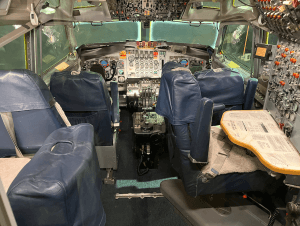
For now, let’s focus on our School Bus scenario.
- Nothing will happen till after–possibly well after–the police even know there is a problem. Fortunately, even younger kids are carrying cell phones in their backpacks, so the rebels in the back of the bus may be able to get a whispered (or texted) 911 call out. That will probably not be an option for you, although you should probably have an innocuous sounding duress word for use on the radio (see below).
- For a school bus, if there is concern the lives of the children are in imminent danger, the opening gambit of a rescue may be a sniper shot, possibly even a simultaneous set of shots, especially if there are more than one hijacker. Simultaneous shots might also be used to make sure they get a lone wolf, as the glass should not deflect the (second) bullet from its intended point of impact.
- Ideally, if your local SWAT team is well prepared, some operators hiding nearby will materialize out of nowhere and place short ladders against one side of your bus (there the potential for crossfire if ladders are on both sides, even if the cover team shoots downward). They or others may perform a “break and rake” on the windows adjacent to the ladders (see below for details).
- Almost simultaneously, the cover team, probably with SMGs or shortie M4s / ARs, will mount the ladders, shooting any hostage takers still standing (or, if downed, still capable of hurting a child). The operators on the ladders will not climb into the bus through the windows, unless the other bus entrances are somehow blocked or wired. Their mission, instead, is to dominate the space inside the bus from the outside.
- Lastly, an entry team will storm the bus–from one end or the other (but not both, again to prevent crossfire), clearing all the rows of seats and finishing and / or handcuffing any hostage takers. If there are no cover officers in the windows, the first officers into the bus will probably “post up” on the left and right, as high as they can get to see over the seats, providing lethal cover down the length of the passenger cab as a three officer contact team works their way down the aisle.
They may throw distraction devices (stun grenades). These are loud and scary but should not hurt you or your passengers. MAKE NO SUDDEN MOVES and follow their instructions exactly.
The above step by step is an ideal solution to the less than ideal situation of a hostage taking on a bus. Unless the students on your bus have parents on the FBI national HRT, the police response you get may not be nearly as pretty or as well choreographed as in the checklist above.
Ever since Uvalde and the Pulse Nightclub, there has been a tendency to treat every bad guy with a gun as an “active shooter,” even if he is a barricaded suspect and / or hostage taker. The theory–and this is partially valid–is that those he already shot may have half a chance if they can get medical treatment in a timely manner. That can’t happen if we’re so worried about any hostages he may have getting caught in the crossfire that we don’t go in right away.
So instead of a fully equipped swat team with sniper rifles and ladders, you may get two patrol officers. One may shoot the bad guy through the window with an AR-15 patrol rifle that does not have precision, magnified optic. One of them may simply storm the bus and clear every row of seats without any overwatch posted inside the front of the bus.
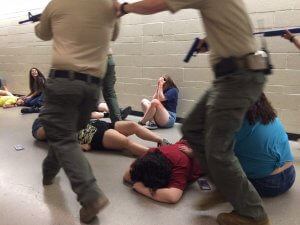
Movies, even those “based on actual events,” are about 90% fantasy, but there is a portion of the movie 6 Days that outlines the third, fourth, and fifth steps of the above-listed bus takedown process in detail. It occurs in a montage between the 34th and 36th minutes of the film. As someone who used to serve warrants, and taught entries, for a living, that sequence is poetry in motion to me.
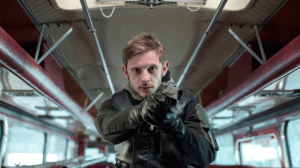
To understand the second step, you might watch 15 Minutes of War (released in French as L’intervention). That movie is not a completely historically accurate account of the Loyada bus rescue (see below), although it is one of the best film depictions I’ve seen of the simultaneous shot technique. Classic FR F1 rifles, and the incomparable Olga Kurylenko, play starring roles.
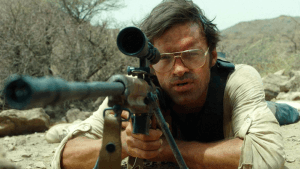
If you drive a bus, it might be helpful for you to know these things, so you can assist in your own rescue by not making it worse. For example, think up some excuse not to move the bus if you possibly can (see below).
Figure out how to keep the kids down out of the windows. This may involve programming them ahead of time by playing games. They don’t need to know your game has anything to do with their survival–till it does.
Try not to let the hostage taker cover the windows with anything opaque.
Some may question the advisability of sharing these bus takedown techniques with the general public. Perhaps, you may think, these methods should be a closely guarded secret. I assure you, terrorists have known about these TTPs (tactics, techniques, and procedures) for 40+ years. And again, as a bus driver, your knowledge of what’s coming next may keep you from hindering your own rescue or getting caught in the crossfire.
Off-Line / Disarm
Of course, no rescue would be necessary if, when he stood right next to your at the top of the boarding stairs, you took his gun away and beat him senseless with it.
That would enable you to roll his carcass out the door, drive to a safer location, and to treat the kid who had been shot. As long as the bad guy is still in play, that kid will be waiting to get medical attention.
Specifics of off-lining / disarming techniques are in other articles, and need to be learned hands-on, but first, you need to undo your:
Seatbelt
Putting this on is something you do habitually. It should be the last thing you do after you close the door and prepare to move, although it will already be on if a bad guy boards in the middle of your route.
We have met the enemy . . .
You already know this all too well, but it bears repeating: if you are a bus driver, the single greatest threat to your passengers is you, and your driving habits.
You owe it to your passengers, and yourself, to be safe, sane, and sober on the road.
The others
A close second in danger to you and your passengers is other drivers, particularly those in large, heavy vehicles. Fortunately, commercial drivers tend to be the most professional, but the standards are lowering constantly in this sad era when too many people don’t want to work at all.
I was driving in a convoy of unmarked LE sedans northbound on Rita, south of I-10 outside of Tucson, when an 18 wheeler blew the stop sign in the T-intersection at Rocket Stravenue at full speed. He must’ve been doing at least 50 miles per hour. He shot the narrow gap between vehicles ahead of me. The 18 wheeler ploughed a furrow out into the desert before the rig came to a stop.
I was the first medic on scene. I thought maybe he’d been texting, or lost and looking around for landmarks, and just didn’t see the stop sign. Turned out, he was out of it. Never figured out if he was suffering some sort of diabetic emergency, or high on downers, or in withdrawal from uppers (he wasn’t scratching meth bugs), or sick, or simply sleep deprived, before local public safety uniforms arrived.
Everybody in that convoy was a criminal investigator, and those who had nearly been T-boned were anxious to interrogate the driver, but as we were feds, we turned the scene over to the locals and Charlie Miked (proceeded on our previous mission of going to lunch).
We wear our seatbelt for two reasons:
- To keep us from flying through the windshield, or hitting the wheel, in an accident.
- To keep us behind the wheel and in control of the bus during sudden, unexpected, high-G maneuvers.
These are both great reasons to wear it, but the moment you sense trouble brewing, in the form of an angry passenger, you need to undo, or avoid putting on, that belt.
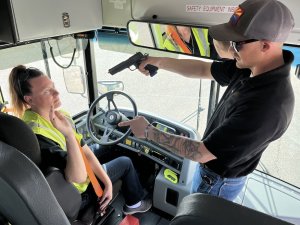
I can tell you from personal experience how the belt can be a hindrance in a fight.
If the vehicle is in motion, DO wear your seat belt, and consider ramming the bus into a heavy, fixed object. This is risky for your kids, but perhaps less risky than trusting their lives to the tender mercies and poor decision making of an armed madman.
Causing an accident will also draw attention–of law enforcement, EMS, and bystanders, not necessarily in that order–to your plight.
Run? Hide? Fight!
Run
We’ve all heard the Run / Hide / Fight (or, if you will, Avoid / Deny / Defend) litany of options for escaping from active violence. But let’s examine them in the school bus context.
As the bus driver, you are captain of that ship. I don’t know a single driver, no matter how timid, who would leave that bus while their kids were in danger.
Running may very well be an option for your kids, while you use the hijacker as a snow board on the stairs. They should know ahead of time that if anything bad happens up front, and you tell them to run, it’s OK to egress from the bus via the emergency exits.
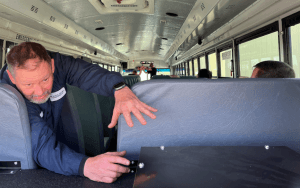
Hide
Kids may be able to duck down in back. Unless they are professionals, hijackers probably won’t know to tell them to put their hands on the top of the seat in front of them and keep their heads down, as a means of controlling them.
But if the killer walks down the aisle, hiding will not avail your passengers for long.
Obviously, hiding is not an option for the driver.
Fight
The time to fight him is NOW, while he’s still close to you.
If he is an “active shooter,” wanting only to maximize his body count to garner as many headlines as he can, and he is climbing onto the bus, the very first person on the bus he will shoot is the driver. If a gun is pointed at you, do NOT wait around to see what he wants. You may find out the hard way. Off-line it as soon as it is pointed at you.
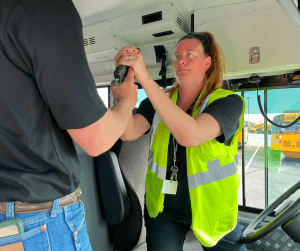
If he has a gun, you will probably want to off-line it in an upward direction, although given your lower starting position in the driver’s seat, you may be faster and have more leverage pushing the gun toward the front windshield instead.
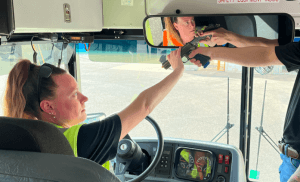
As mentioned above, this skill is best learned hands-on, although you can read Isandhlwana and the Pulse Nightclub for more information.
If he’s out of reach
But now let’s assume you never got the chance to grab his gun, or that by the time you got over your initial shock, he had moved out of your arms’ reach.
Knowing that the opening gambit of a rescue attempt may be a sniper bullet or bullets flying horizontally through the cab, resolve to stay down, keep the kids down, and NOT to move the bus.
Unless he, like the Long Island Railroad killer, started out pretending to be normal, sat in the back of the bus, and started shooting those closest to him first. On a city or long-haul bus full of adults, the response to an active killer in the back or the middle is that the closest people must swarm him. Those near the exits–including the driver–can bail.
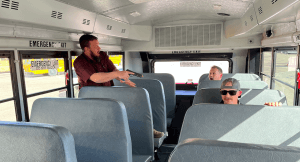
But if an active killer is on a school bus, the driver IS the adult supervision. The captain of the ship. If the shooting has begun, you cannot abandon your children to their fate. If you do, you may survive that day, and their parents may even say “there was nothing you could do,” at every funeral, but you and they will all know that’s a lie.
You would regret it every day for the rest of your long life.
Instead, charge him and knock him down.

It CAN be done, even if you are shot along the way. Google Jason Seaman if you don’t believe me.
Despite what you may have seen in the movie Shooter, long distance head shots on a target moving rapidly at vehicle speeds are virtually impossible. Your police marksmen and their spotters need time to find a good firing position with a clear line of fire. They can’t do their jobs if the hostage taker is moving all across town in your bus.
Stall him verbally. Your story will be more believable if you’ve thought through your excuse for why the bus won’t move ahead of time.
If you feel that someone–like you–will die if you don’t drive the bus, it’s OK to do so. Just realize that motion works in the bad guy’s favor, and understand that the police will stop you, somehow, some way, before they can board.
Many modern city buses have advertising on the outside of the windows. This limits the sun coming in and does not generally obscure the view of the outside from the inside. Unfortunately, this advertising makes it very difficult if not impossible for police marksmen to see into the bus through the side windows. During the Mothers Bus incident (see below), the Israelis solved this problem by shooting through the windshield.
Duress Words
When I worked in nuclear security, everybody involved had to know the local duress word, and the alternate duress word for use should the primary word be compromised before a new duress word can be secretly disseminated.
The duress word should be something innocuous but unusual. Not something you would usually say, but something you can slip into a “normal” conversation to surreptitiously tell the other person that you are being held hostage.
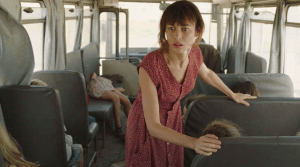
“Zebra,” for example, is unusual and not unheard of. “Anit disestablishment interianism” would be a lousy duress word; who can remember that mouthful? But zebra may be difficult to work into a normal-sounding conversation on the fly. If the bad guy is not listening to both sides of the conversation, you could say “Naw, we’re busy Saturday. I’m taking my kids to see the zebras at the zoo.”
But the bad guy will probably want you to put it on speaker, and unless you are wearing an earpiece, the radio is always on speaker.
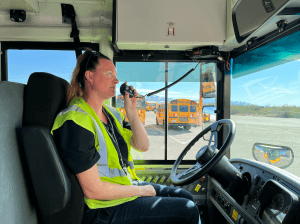
Think of how you would work the duress word into a conversation as soon as you learn it. That way, you won’t have to ad lib while some nutjob has a knife to your throat.
Case Study of a Well-Executed Bus Takedown: The Mothers Bus
One of the best examples of a surgical bus takedown occurred on 07 Mar 1988 in the Negev desert. Terrorists armed with AKs, grenades, and a submachine gun hijacked a bus filled mostly with working moms.
Some of the passengers were able to run away before the Tangos boarded the bus. Later, the escaped PAX gave valuable intel to the rescuers.
Despite the lack of vegetation, Yamam (a police counterterrorism unit composed of select military vets) were able to crawl close to the bus with short ladders.
The bus had curtains in the side windows. Snipers initiated the assault by shooting all three terrorists simultaneously through the windshield and the rear window. According to Israeli Major General Avshalom Peled, who had participated in the takedown as a platoon leader in the Yamam, one of the Tangos wasn’t quite dead and was shot again from above by a commando on a ladder, after they broke out the windows with hammers.
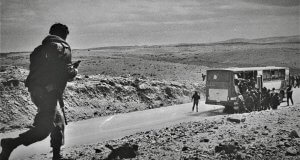
The entire takedown took seconds. They rescued the 7 remaining hostages, but 4 others had been killed before Yamam got the green light.
Making Your Bus Less Mobile
If you are already rolling when a passenger stands up with a gun or knife to hijack your bus, or if he storms the bus and you roll before you recover from your shock, you can expect that rescue forces will stop you in a time and place of their choosing. That may entail them shutting your bus down in some way, or cutting you off / blocking you in with a dump truck or armored vehicle.
Many long-haul buses and city buses have a “kill switch” in the back engine compartment. Some school buses as well. Your rescuers may hit this when you are stopped at a traffic light.

If the hostage taker has a knife in the back of the bus you can take the key and run away. This immobilizes the bus and no matter what he says he’s not likely to take it out on the passengers, as they are his shield. If the passengers are dead, there’s nothing to prevent the cops from storming the bus and killing him. However, we should not count on a hijacker acting rationally. The bottom line is, immobilizing the bus, in such a way that the hostage taker can’t make it go, no matter who he threatens to kill, is more often than not a good thing, more likely to contribute to the survival of your passengers than cooperating with the hostage taker.
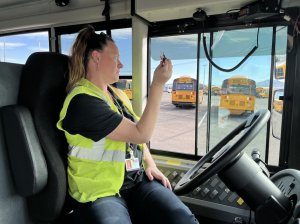
You can assist the assault team by “accidentally” knocking the rear view mirrors off on fixed objects near the road (like a wall or stop sign). This requires some skill as a driver and some acting ability to make it look like you were distracted by his scary presence. “Adjusting” the mirrors thusly may enable the team to approach the bus from the rear with less chance of being spotted by the hostage taker(s). It will also draw LE attention to your bus if the word has not gotten to the dispatchers yet.

You WILL be scared. If not, you’re an idiot. But having a plan and placing it into action can be very calming. It gives you something to focus on in times of crisis.
After they disable or immobilize your bus, other law enforcement officers may burst out of a nearby building or van.
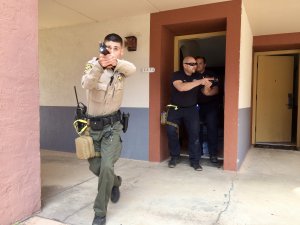
As mentioned after Step 5 above, the rescue team may distract you (and the hostage takers) by tossing a flash-bang grenade, possibly on the outside of the bus opposite their approach.
What to expect from the cover officers at the windows
Any direction of entry team approach to a bus works better when an exterior cover team, perched on ladders, boxes, or nearby cars, is dominating the interior from one side or another, rather than the back, but that may not be possible if there is no concealment for the exterior cover team’s approach from the side.
If no ladders are available, one officer might kneel while another stands on the kneeling officer’s thigh.
The cover team could also be marksmen with magnified optics placed farther out–until the contact team makes entry (see Appendix I below).
Ideally, there are enough rescuers to post one cover officer at every other window.
Ideally.
And ideally, the Little Red Haired Girl would grasp that Charlie Brown is a young man of character, conviction, and promise. As Peppermint Patty told him, “We live in a real world, Chuck.”
You go with what you get. That may mean only two cover officers for the whole bus. Or none.
They may or may not perform a break and rake (breaking windows and raking the sills so clambering or leaning in would be less hazardous, and then sweeping any glass sticking up or curtains out of the way with a hammer or hooked tool). The greater the perceived risk, the greater the likelihood that the cover team outside will break windows, but the preference is NOT to break the windows. Not because we really care about the windows–they can be replaced–but because of the potential for injury to the hostages.
Bullets, of course, are no great respecters of automotive glass.
In the likely even that they do NOT break and rake, they should hold the muzzles of their weapons a few inches off the glass. If the muzzle is in contact when they take a shot, more glass will fly in all directions, including back at the operator.
If there are curtains or jackets or whatever placed in the windows to obscure the rescue team’s view, raking (sweeping a hooked tool like a hammer from one side to another after breaking the glass) will be almost essential.
What to Expect from the Entry Team
Perhaps the single best thing you as a driver can do to assist in your own rescue is to ensure that pneumatic pressure, or electric power, or hydraulics, or whatever it is that holds the door shut has been drained or disconnected, as you might for an emergency exit. This will enable the rescuers the quickest, least risky entry.
“In a bus assault, the breach [getting in the door] is the most critical thing.”
–Larry Forcum, former SRT commander and instructor for numerous SWAT schools
One rescuer may lean in through your driver’s passenger window to open the door. Make sure you leave that window open, or be on the lookout for signals from outside to open the door(s).
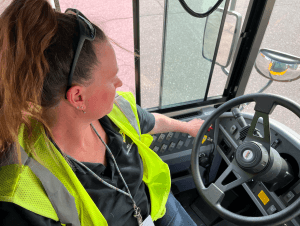
If there are NOT cover officers on ladders by the windows, the first one or two rescuers who board will probably post themselves at the front of the bus to cover the entire length of the passenger cabin. They may “gank” the driver out of his or her seat and toss them off the bus to make room for the cover officer to climb up on the seat. Do not be surprised or offended if this happens.
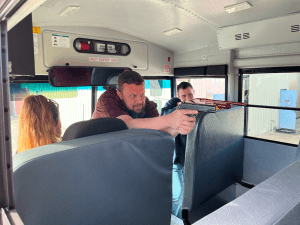
They will likely order the passengers to place their hands on the top of the seats in front of them, with their faces down (my personal preference), or to put their hands on the tops of their heads with fingers interlocked.

If it is a school bus, they may enter and dominate from the rear exit. With the old-fashioned rear exits, which are more like doors, his would enable them to see under the seats, but kids hiding, and the rear wheel wells, may obstruct their view from below seat level in back.
Being outside on the ground also limits their view over the tops of the seats until they get higher. This may be accomplished by standing on step ladders, stools, or boxes behind the school bus.
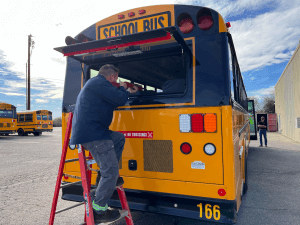
Ideally, the team moving down the aisle will be three officers. The first works her or his way down, clearing each row of seats as they go.
If your passengers are young children, and the hostage taker is an adult, IFF (identifying friend from foe) should not be much of a problem.
Some adolescent mass murderers have been known to wear a “Jason” mask, or a shirt with “F U” (spelled out more completely). One even had a shirt that said “Terrorist.” Ski masks, while not universally used, are a dead giveaway.
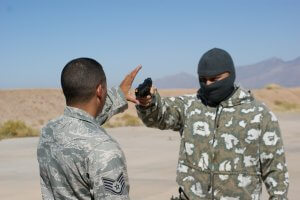
- If the point officer encounters a potential hostile, point will become the “Contact” officer. Contact does all the talking. If that bad guy needs to be shot, Contact will do it. More likely, point will holster up and go hands-on. But first,
- The second officer will take over as point, covering down the aisle and all as-yet uncleared portions of the passenger compartment.
- The third officer will move into the seat ahead of the one with the suspect, on the same side of the bus, and provide lethal cover (be ready to shoot) as the first (Contact) officer goes hands-on.
Contact will then march the suspect off the bus, or hand him off to a comrade on the arrest team behind them.
Then the three officers will continue clearing the rows of seats, rotating the roles of Point to Contact, Two to Point, Three to Cover, and so on.
What to expect from Arrest Teams
Any spare officers will wait by the door, with one or two making entry as necessary to escort someone out. As the contact team clears the bus, those who were previously posted at the windows covering down on seats that are now cleared can peel off like a banana and join the arrest team in the front of the bus. Securing the passengers (and any wolves in sheep’s clothing hiding among them) is labor intensive, requiring many hands.
We need to be sure. ALL passengers will be evacuated and placed on the ground in a line about 45 degrees from the door (going forward and out from the bus), starting several feet from the door to keep it clear.
Everyone on the bus may get zip tied before the rescue force can sort everyone out.
Resistance
Knowing what to expect can increase your chances of survival, and most importantly, those of your passengers.
Whatever you do, do NOT let him take you out in the boonies where he can murder you with few witnesses.
Your best bet is probably to fight him as soon as you realize there is a problem. If there are too many bad guys to fight, stay low and make sure your passengers do the same. High-speed projectiles may soon be traversing your bus at standing chest level or higher.
We need to define “fight him” here.
When fighting a lone wolf within the tight confines of a crowded bus (or elevator or subway train), you are probably better off gong hands-on, if you are close enough, rather than shooting him, even if you are armed.
There are ways to shoot bad guys at close range from retention holds, but most people don’t practice them. If you are in a wrestling match, your gun could well be a liability to you.

But more importantly, there will likely be other innocents in close proximity. They can cause shoot-through issues.
Instructions for Responsibly Armed Passengers
The second to last thing you want to do is send a bunch of bullets into the crowd behind him (the very last thing you want to do is get into a knife fight–ever–unless you are the one with the knife, you can get inside the minimum effective range of his rifle, and you know how to handle a blade).
Avoid getting into a gunfight in a crowded bus (or a crowded store). If the bad guy starts killing people, or looks like he’s about to, so you have no choice because you are out of arms’ reach (or he has a known friend), you can usually get a clearer line of fire by kneeling in the aisle and shooting at his head. Your bullets that miss or over-penetrate should fly over the heads of the passengers on the other side from him.
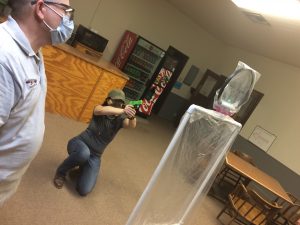
Unfortunately, getting low does NOT keep you from shooting a passenger in the back if they jump between you to tackle him. Issue commands, and be LOUD about it, so everybody knows you are a good guy, even through any auditory exclusion they may be experiencing.
Once you have put him down, have a passenger kick his gun away from him, or stomp on his gun hand. Put your back to the nearest “wall” (one side of the bus or the other) and scan fore and aft for additional immediate threats. If you are not sure you can safely move through the crowd to the back of the bus, stay there.
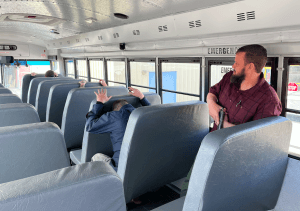
If you don’t see any obvious and immediate foes, get to the back of the bus. In a long-haul (Greyhound type) bus, that puts your back quite literally to a wall. Regardless of what type of bus you’re in, if gives you a better view of the entire space and of the passengers in it (possibly also of approaching rescuers). From the middle, you would only be able to see one half of your space (the front or back of the passenger cabin) at one time.
Give instructions. Be polite but firm and speak loud enough to be heard by all. Tell them to stay seated facing the front. Those who turn around may (key word, MAY) be sleepers or layoff men.
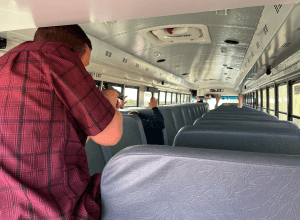
On your way there, hold your handgun in a retention position, such as Center Axis Relock (CAR).
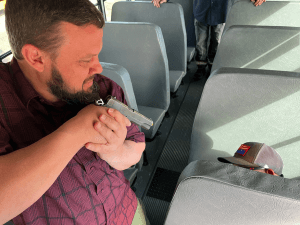
Whatever you do, DROP YOUR GUN LIKE IT’S ON FIRE when you even begin to suspect that the uniforms are approaching.
Do exactly what they say.
Ideally, have the driver exit to let them know you are a good guy before they board. Identify yourself, but expect to be cuffed and stuffed till they sort everything out.
Appendix I:
Simultaneous Shots
Designated marksmen simultaneously taking out known, visible bad guys as the opening gambit of a rescue operation is a classic counterterrorism TTP. It is particularly useful if the Tangos hijack a bus or train (or demand a bus to take them to the airport), but it can be used in other situations, especially if there are glass barriers that might deflect the (first) bullet.
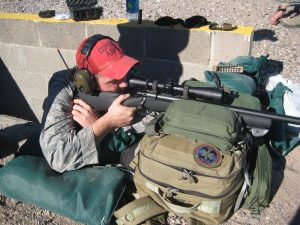
Unfortunately, this counter-terrorism TTP has not always been with us.
The Munich Massacre
I have vivid memories of watching the 1972 Munich Olympics on ABC’s Wide World of Sports. “The thrill of victory and the agony of defeat” took on an entirely new meaning for me when terrorists kidnapped and later killed Israeli athletes, along with a significant portion of my youthful idealism.
German security forces decided to attempt a rescue when the tangos and their hostages arrived at Fürstenfeldbruk Air Base at about 2230 hours local time on 05 Sep 1972.
Five West German policemen were voluntold to be riflemen in the rescue. Some were selected because “they liked to shoot on weekends.” I’ve read that they had no specific police sharpshooter training. Even if they were experts with scoped sniper rifles, they were too few; what German planners had believed to be five terrorists turned out to be eight when the helicopters arrived from the Olympic village.
According to printed sources, German police were armed with standard G3 rifles, using iron sights alone. It was dark out, although parts of the airport were brightly (perhaps too brightly) illuminated.
Two terrorists went to inspect the Lufthansa 727, leaving the other six to guard the hostages. The tangos may have smelled a rat when they found no aircrew in the airliner. When the Germans opened fire–and missed–the tangos ran back to the choppers, where the hostages were, hid under and around them, and began shooting both the hostages and the airport lights.
They also tossed grenades, blowing up the helicopters with the hostages inside.
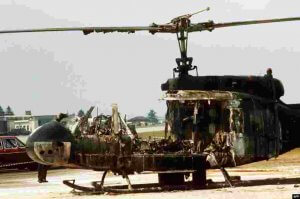
The police “snipers” did not fire in concert, and had a hard time seeing the terrorists (or their front sights) in the highly contrasted, mixed (very bright or fairly dark) light.
Manfred Schreiber, Munich Police Commissioner in charge of Olympic Security, later explained that by law and tradition, West German police were trained to shoot at extremities, rather than “to kill.” Gee, Wally, it’s a good thing they did, or otherwise some of the terrorists might’ve gotten hurt in the first volley. See Where to Shoot a Kidnapper for some better ideas.
All the Israeli hostages were killed.
Five of the eight terrorists died in the ensuing gunfight. The helicopter pilots may have been killed as well. A German police officer in the tower next to Schreiber was killed.
Legs and arms are almost impossible to hit selectively when the target is running, no matter what they do in the movies. Make no mistake: a leg or arm shot is “Deadly Force,” with all the attendant moral and legal consequences. Even if you hit that moving target, a leg or arm shot will take longer to stop him. Aim for the center of mass; it’s harder to miss.
I’m not judging the brave polizei who did their best on short notice in a horrible situation. I am hoping that we can learn the lessons those athletes and that cop paid for in blood.
After that gallant but disastrous attempt, the Western World started getting serious about counterterrorism.
The Loyada Bus Rescue
This was the simultaneous shot most often referenced in hostage rescue manuals and professional journals.
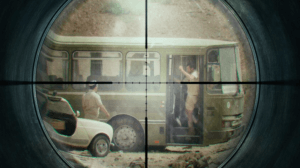
On 04 Feb 1976, French Gendarmerie marksmen (from a counterterrorist unit later called GIGN) used the simultaneous shot technique to take out 4 Somalis who had seized about 30 children on a school bus, near the town of Loyada (on the Somali border with Djibouti).
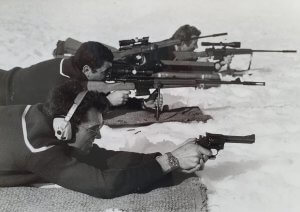
According to a diagram prepared by the Foreign Legion, the bus was about 183 meters from the sniper hide. Unfortunately a fifth terrorist ran onto the bus and shot some children before he, too, was taken out.
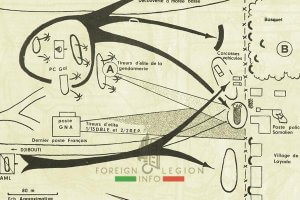
The surgical strike, known as the Loyada bus rescue, precipitated a somewhat less surgical gun battle near the bus between the Legionnaires and the Somali border guards, who sympathized with the Tangos, but the vast majority of the children were saved. One child died on scene, one died enroute to the hospital, and one who had been shot in the head killed himself many years later.
Dutch Train Rescue
The first reference I’ve seen to training for a simultaneous, preemptive sniper strike was about the Dutch State Police and Marines in the early 1970s (Counterattack: The West’s Battle Against the Terrorists, p. 113).
It would be a stretch to say the Dutch used simultaneous snipers to end the 20-day train siege five years after Munich (23 May – 11 Jun 1977). Rather, Dutch Marines assaulting the train riddled the train cars known (through audible surveillance) to contain the Moluccan terrorists, after buzzing the train with magnificent F-104 Starfighters to get the hostages’ heads down and the Moluccans looking up.
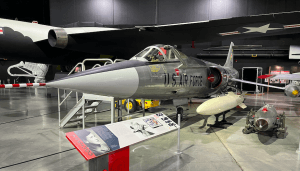
Allegedly, the Dutch Marines fired 15,000 bullets. I was peripherally involved in a gunfight in which the round count–more than a hundred shots fired–was very high by police standards. I find the 15,000 number listed by Wikipedia difficult to believe. I might buy 1500–but what difference does a silly decimal place make?
Either way, this was an example of what’s NOT a surgical, simultaneous sniper shot. The Dutch rescuers killed 6 terrorists and at least 1 hostage who was in the wrong car at the wrong time. When researching this incident, don’t confuse it with another Moluccan train (and simultaneous consulate) siege that took place a year and a half before, starting on 02 Dec 1975.
The Good Guys! store in Sacramento
A tragic example of where the simultaneous shot method might have worked better was on 04 Apr 1991, at the Good Guys! store in Sacramento, CA.
The Sacramento County Sheriff’s Department Special Enforcement Detail (SWAT team) had surreptitiously entered the back of the store. They were to commence pressing to the threats when their sniper took out the visible bad guy in the front of the store.
The sniper took the shot through an open glass door, but as fate would have it the door swung shut at that exact moment. The door shattered, but deflected the bullet just past him. The bad guy shot several hostages, just for spite, before the SED got to him.
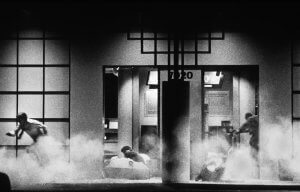
Had there been two snipers available for (even nearly) simultaneous shots, perhaps one of the bullets might not have been deflected. But only God knows.
Of course, the press described the vicious criminal gang that hit the Good Guys! store in Sacramento as “misunderstood immigrants with assimilation problems.” The Moluccans on that Dutch train had, in fact, been immigrants with major, generational, assimilation issues (still no excuse to hijack a train, lay siege to a school, or kill hostages). The punks who got interrupted robbing the Good Guys! store happened to be immigrants, but for the most part they were just spiteful street thugs, despite the drivel spewed to negotiators and news reporters after their robbery went south.
Practicing the Simultaneous Shot Technique
On the Adam Brown range at Clint Smith’s Thunder Ranch training facility, I had the privilege of practicing simultaneous shots on multiple targets under the tutelage of experienced LE and military riflemen (including one woman).
Although the target audience–pun intended–for this article is bus drivers, two of the four people who actually read the articles I post here are in law enforcement and / or the military. This part of the appendix is for them.
On the “T” of “Three”
Your designated bad guy should already be in your sights, and every shooter should confirm that they have a clear shot, before the team leader starts counting down.
The following countdown would apply to all those involved in the rescue effort. As marksmen, our instructions were to fire on step 3, not 1 (or zero).
- Standby! (flip off safety, if any)
- 5 (find trigger)
- 4 (slack out of trigger)
- 3 (simultaneous shots to take out visible bad guys)
- 2 (entry team breaches the door)
- 1 (the team goes in).
Steve Rodriguez, who was a sniper on the Albuquerque PD during his long and illustrious law enforcement career, explained the scenario: a proactive green light on the authority of a trusted person in the know about downrange conditions and events.
When Steve had to shoot a hostage taker from the courtyard of a dentists’ office in Albuquerque, he had not been able to see the hostage taker’s pistol over the wall of the courtyard. Indeed, he could only see 2/3 of the bad guy’s melon around the hostage’s head. When he said “I don’t see the pistol,” Steve was told “He’s got one. Take the shot.”
You must be able to trust the people you work with.
We all practiced the Simultaneous Shot drill dry, a little out of rhythm, before trying it live fire. On the first live run-through, most of us took the shot at close to the same time.
On another countdown, some folks cranked their rounds off on 4. Steve–who’d been behind the sniper’s rifle in some tense, do or die situations–said “The Hostage is dead, thanks to you!” He was deadly serious about the margin for error with this deadly serious tactic.
When I had worked in LE, we were instructed that perimeter riflemen were NEVER to fire into the structure after the warrant service team had made entry, regardless of what we saw through the window. This was, of course, to prevent blue on blue. So firing on 1, instead of 3, was a no-go.
Firing into a structure or bus full of scared, wounded, or dying hostages is not the same thing as shooting after the team has made entry. It’s risky but acceptable under certain circumstances, because unlike the cops on the entry team, the hostages cannot defend themselves. If you don’t stop him, even from a distance, who will?
Our next runs through the Simultaneous Shot drill were spot-on.
On the last run, my group got shifted to the 200 yard 5’8″ man. Between all of us, we hit three targets at one time. No dust behind the steel targets (misses) from anybody in the line.
It was very gratifying for all of us to pull together as a team to accomplish that, each person doing their part in synchronicity.
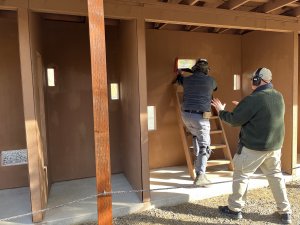
Clint Smith and crew had taught this same method to Tier One operators who have actually used that skill to neutralize terrorists; see Appendix IV.
Shooting into a bus or anything else that contains live hostages–especially kids–is something that would only be done circumspectly. But as at the San Ysidro McDonalds on 18 July 1884, a well-aimed bullet by a police marksman is a lot less dangerous to people inside than the threat posed by an armed, unstable bad guy.
Appendix II:
“But then, either through incompetence or anger or both, he shoots the kid.”
–From the scenario at the beginning of this article
Not an unrealistic scenario. Bad guys tend to be untrained, and are almost universally not great respecters of Rule 3:
Keep your FINGER OFF THE TRIGGER, indexed up alongside the frame, until you have made a conscious decision to shoot.
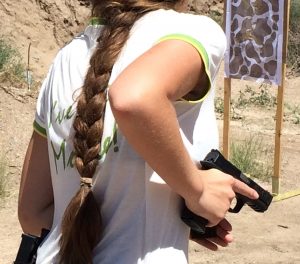
When I first came over from Patrol and began working as a Special Agent, I was assigned to the Criminal Alien Program (CAP). Our job was to make sure that foreigners convicted of other crimes went away after serving their sentences. It wound up being a “get out of jail free” card for those pending charges on lesser crimes, but that is another story.
One of my first jobs was to set up a triple murderer for deportation. His charges were still pending (he wound up getting life sentences, so the deportation proceedings were theoretically moot). I was strictly advised not to question him about the circumstances of the homicides, which had taken place on 17 Jan 1999, during a robbery in a Pizza Hut on the East Side of Tucson.
According to the written record, both he and his partner in crime claimed the other did the killing, after they both robbed the place.
There were three Pizza Hut employees on duty: 44 year old manager Bob Curry, 20 year old server Melisa Mae “Lisa” Moniz, and 17 year old bus boy James Andrew “Jimmy” Bloxham. The robbers tied at least two of them up. Then, at some point, somebody got shot.

Judging from demeanor and age of the suspect I interviewed, and based on my years teaching shooters, I’m guessing that the first shot may have been accidental. He and / or his accomplice probably had their finger(s) on the trigger, and shot somebody without really intending to. After that they felt forced to eliminate the other two witnesses. NEVER LET THEM TIE YOU UP.
If somebody in your bus or car has a gun, and their finger on the trigger, their response to a loss of balance (as you might cause by slamming on the brakes) will be to clench their fingers–resulting in a negligent discharge (ND). If they are not respecting Rule 2, either, pointing it at somebody on your bus, we could lose a passenger or two.
Your best (or least bad) bet, if he is within reach, is to control the direction of his muzzle, pointing it in a safe direction. That, too, will result in his clenching his hand and finger muscles, with a subsequent ND. But if you off-line it fast enough, the gun will go off AFTER it is pointed in a safe(r) direction.
This is because action is always faster than reaction (more specifically, because of the OODA process). We demonstrate that this actually works in off-lining and disarming classes.

Appendix III:
Response to Vehicle Ambush
This is outside the scope of an article about vehicle interiors, but since the target audience of this article includes bus drivers, bad guys taking shots from outside the bus probably needs to be addressed, at least briefly.
We need to concern ourselves with two types of ambush:
- From fixed points (overpasses, buildings, or on the ground outside your bus), or
- From other vehicles.
Ambush from on foot
There are basically two types of ambush from fixed points:
- Hasty or spontaneous, and
- Prepared, which is to say planned.
Hasty Ambush
If you are driving through an area when some idiot starts taking pot shots at your bus, KEEP DRIVING.
FASTER, IF AT ALL POSSIBLE.
When you hear what sounds like someone hitting the outside of your bus with a hammer, our inclination is to stop and investigate. After all, if you were filling up your car at a gas station when you see another driver pulling out as their gas cap falls off their trunk lid, you might yell out. If their window is up and they don’t hear you, you might chase after them and slap their fender to get their attention.
As a bus driver, if you have any indication that your bus is taking fire, you must resist the natural inclination to stop. Accelerate out of the kill zone.
Drive directly to the nearest hospital or at the very least, a well lit, well populated area, while radioing in the situation to dispatch.
Planned Ambush
If the ambush is well planned, they will stop your bus to keep it in the kill zone. This typically happens with a roadblock. They could park a vehicle or vehicles across the way. If the bad guys do their planning right, they will do this in a narrow “choke point,” where they can block you in and don’t need as many vehicles to keep you from driving around.
In wooded regions, especially on windy, narrow roads, this is typically accomplished with a felled tree, usually right around a bend in the road so the driver cannot see it from far off and avoid it. In Tucson, I suppose they could fell a saguaro, but saguaros weigh tons–literally. I never tried to tow one into position across a road, but I imagine that would be problematic. Out here they will probably use vehicles to block the road.
Once they have you stopped, they will either attempt to board your bus or commence firing.
Generalized Civil Disturbance Roadblocks
Roadblocks, with vehicles or burning tires or piles of garbage cans and such, are common during civil disturbances. During “mostly peaceful protests,” they may link arms across a road or even a freeway.
The intent here is not to usually ambush and destroy you, although they may beat on the outside of your bus. Usually, their intent is to snarl traffic, making the lives of the “haves” inconvenient to draw attention to the plight of the “have nots” or some other social issue.
The worst they will probably take from you is your time.
Keep in mind, though, that stopping to avoid pedestrians did not work out so well for Reginald Denny.
Best not to get stopped, and to avoid troubled areas altogether, if you can.
To push–SLOWLY–though a linked arm crowd, aim toward the outside. They will tend to bow away from you.
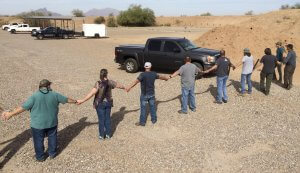
If you try to push through the middle, they will bend in around you and be less likely to give way.
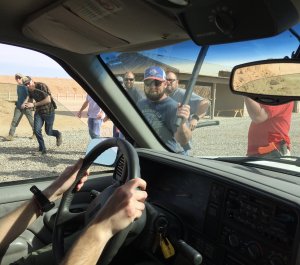
If they start to break windows, that would endanger the kids in your bus, and would be reasonable justification for you to apply a little more gas to escape.
Vehicles as Roadblocks
If you are concerned for the safety of your passengers, keep in mind that your bus has a lot of brute pushing power. Steer a front corner of your bus toward a wheel on the lightest looking roadblock vehicle–preferably toward the side OPPOSITE the engine, which is lighter and easier to pivot out of the way.
Don’t try to smash through like in the movies. Rather, make contact slowly, then PUSH through, turning the roadblock vehicle out of your way as you go.
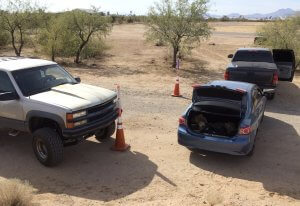
Ambush from Other Vehicles
There are–yep, you guessed it–two types of vehicles we need to be concerned about:
- Motorcycles, and
- Cars (sedans, vans, SUVs, pickups, crossovers)
Motorcycle Attacks
Are a common terrorist TTP, especially in crowded cities where automobile traffic is often at a stand still but motorcycles can escape by winding their way through the gaps and down narrow alleys. This is NOT a likely TTP used against buses (see below).
Typically there are two assailants: the person in front drives and the person in back does the shooting.
Side view mirrors are your best defense. If you see somebody on a motorcycle behind you pulling out a gun, they are about to make a run. Your first, best response is to turn into them.
If you are lucky, you will save some lives (and perhaps even save the taxpayers the expense of their trial and incarceration) by knocking them off their bike.
More likely, the quick, agile motorcycle will be able to evade your lumbering bus. But if they have to shoot a gap between you and oncoming traffic, they will be ahead of you, where they don’t want to be. You can track them, avoid them, or run them over if they are ahead of you. At that point they are likely to abort their attack.
Even better news, for bus drivers, is that, while motorcycle attacks are often used against individuals in sedans or SUVs, they are not often used against buses. The bus is too high up compared to the motorcycle. It looms over them and makes it harder for them to select targets. Anything can happen, but I would be very surprised to read about a motorcycle attack against a bus in the USA.
However, the following scenario is not as unlikely:
Your school’s team won a resounding victory in tonight’s competition. You take the team or the band or whatever to the local eatery, in the other school’s territory. Some of the kids are a little too exuberant, and a confrontation ensues. The sore losers are ejected from the eatery.
Sullen, they return to their car and talk each other into vengeance for perceived slights.
As you pull out of the parking lot with your team on board your bus, an SUV races around to your left, while two “bangers” lean out the windows, stitching the side of your bus with bullets.
Car vs Bus
Your best bet, as soon as you see guns hanging out of the car, or hear the gunfire and see flashes in your side mirror, is again to turn toward that mirror’s side, for the same reasons listed above. Automobiles with more than two wheels will have a harder time avoiding you, and even a full-sized pickup truck will still lose if it comes to playing bumper cars with a bus.
If their driver is adept at avoiding you–his car is still more maneuverable than your bus–keep your bus to the left side of the road as far as the roadway and on-coming traffic will allow. This will force them to pass you on the right. Unless their gunners are in the back of a pickup truck or sticking out of a sunroof or in a convertible, their firepower will be limited to their left side–that is, in countries like ours, where the driver’s seat is almost always on the left.
I plan to do an entire article about vehicle vs vehicle attacks soon. When I do, I’ll post a link to it in this post.
Appendix IV:
Selected Sources
Frank Bolz, Jr., Kenneth J. Dudonis, and David P. Schulz. The Counterterrorism Handbook: Tactics, Procedures, and Techniques, 2nd ed. Boca Raton: CRC Press, 2002.
Detective Jennifer Fulford. “Shot Ten Times,” in Loren W. Christensen’s Warriors. Boulder, CO: Paladin Press, 2009. Deputy (later Detective) Fulford’s incident was one in which young children with cell phones, strapped into the back of their mother’s mini van, were able to dial 911 and contact the police when armed home invaders took their mom from the garage into the house. Kids in the back of your bus will probably do the same thing.
Cecil Pearson and Eric Radli. Hostage Situations: From Crisis Intervention to Dealing with Terrorists. San Clemente, CA: LawTech Publishing Co, Ltd, 1999.
Lt Col Joshua Potter, Commander Gary Stubblefield, and Mark Monday. Ambush! A Professional’s Guide to Preparing and Preventing Ambushes. Boulder, CO: Paladin Press, 2010.
Jay M. Shafritz, E.F. Gibbons, Jr., Gregory E. J. Scott. Almanac of Modern Terrorism. New York: Facts on File, Inc, 1991. This source is a bit dated and is not a completely comprehensive overview. Rather, it’s a good place to start one’s research. It also helps to corroborate dates, numbers of hostages, etc.
“Not My Problem:” Course Notes, Clint Smith’s Old Rifle course. Thunder Ranch, Oregon, 02 – 04 Dec 2021. Significant portions of this article were excerpted from the after action report (AAR) I wrote of that training.
John Spencer. The Evolution of Hostage Rescue Tactics: Understanding the Significance of the Mothers’ Bus Attack. West Point Modern War Institute, 06 Jan 2023. A podcast sponsored by the United States Military Academy which has a detailed interview with a participant in that rescue.
Leroy Thompson. Hostage Rescue Manual. London: Lionel Leventhal Ltd, 2001. Esp. Chapter 9, “Operations against Vehicles and Trains,” pp. 148 – 161.
Special thanks to Jerry Brown, Director of Transportation for the Vail School District near Tucson, AZ, for making training available to his transportation staff, and for making members of his staff available to me. Thanks also to the Vail Transportation staff who assisted by showing me the features of their very modern school buses, and for role-playing in many of the illustrations in this article.
Thanks also to Larry Forcum, God rest his soul, the most experienced and knowledgeable SWAT operator and instructor I ever knew, for his contributions to this article. Larry’s team won a national SWAT competition doing a bus takedown. He had been through countless real doors serving high-risk warrants. Larry served his nation well throughout a long and distinguished career. Sadly, he passed away at home in November of 2024.
In reviewing this document, Larry pointed out to me that the “ideal” type of bus takedown described above is very uncommon–an almost unheard-of unicorn. Tier 1 hostage rescue teams like the SAS and FBI HRT practice bus takedowns but rarely if ever get to do them, because it is no longer acceptable for local authorities to wait long enough for them to get there.
Hostage rescue teams have almost worked themselves out of a job. The active killer is taking the place of the hostage taker. Even when hostages are taken, police who do not treat the situation like an active killer event are accused of cowardice. Those who do charge into the firestorm that awaits them to rescue your kids are sued (and now, potentially jailed) when hostages get caught in the crossfire.
For centuries, law and order has been symbolized by Lady Justice, the image of a blindfolded woman with a sword in one hand and scales to weigh evidence in the other.

What most people can’t see, balanced precariously on a ruler between the scales Lady Justice holds, are street cops who must quickly decide between containing the incident and waiting for tactical teams, or charging in there, possibly getting killed, possibly getting hostages killed, and possibly getting sent to jail for doing what they need to, to go home to their families afterward.
Even without the time or resources to do it right, I hope this document has provided those who might have to rescue kids on a bus with some ideas they can use to at least do it better.

It should be noted that any errors or omissions in this document, and any opinions expressed therein, are strictly my own. Nothing in this document should be construed as being endorsed by the Vail School District, nor as the official policy of any of my former employers, including but not limited to the DoJ, the DoD, and DHS.
Appendix V:
Both the Extent and Limits of my Expertise on this Subject
or,
How Much Can You Trust This Internet Info?
In the Security Police, and later in the Security Forces, I had a bus license and I occasionally drove 29 passenger (“PAX”) posting buses. Usually it was just from our armory to, say, our weapons storage area, but occasionally it was longer road trips like from Cheyenne to Ft Laramie, or Riyadh to King Khalid International Airport.
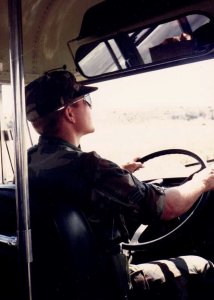
During the first decade of my military career, I worked in nuclear security. I guarded aircraft during Operation Desert Storm, and later during Op Iraqi Freedom.
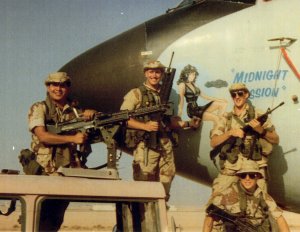
Our biggest concern in those military security gigs was terrorism.
“Terrorist” (or, if one wishes to sound edgy and experienced, “Tango”), is an umbrella term that is used to describe insurgents, sappers, guerillas, saboteurs, assassins, and even spies. The motivations of a religious extremist may be entirely different from those of a narcoterrorist, but there is considerable overlap between the two in methodology and ends.
Guarding jets and even nuclear weapons from Tangos did not make me or the grunts I worked with counter-terrorism commandos. And although I was on our base Emergency Services (Security Forces SWAT) Team, and later in life peripherally involved in HSI Special Response Team warrant service operations, and even trained with our SRT as a Tac Medic, I was never a Tier One operator.
I did, however, learn a few things about tubular targets along the way.
The first tubular targets I trained to take down were ICBM Launch Control Centers (LCCs), 80 feet below ground. The entire complex, including the soft-sided above ground support buildings, was called a Launch Control Facility, or LCF. As a Flight Security Controller, the “last line of defense” for ICBM LCCs, I studied and pondered the subject at length.
I authored a pamphlet, “LCF Recapture Primer,” proposing specific TTPs–Tactics, Techniques, and Procedures–for getting from the Tunnel Junction into the concrete LCC alive, and taking it back from any threats inside. Even though that was over 3 decades ago, I’m still not at liberty to discuss specifics here, as my guidelines were designated UCNI, unclassified controlled nuclear information. While systems have been upgraded, the layout of the capsules hasn’t changed all that much.

Throughout my civilian law enforcement career, I had occasion to board and search buses (and cargo trains), especially during my years in Patrol.

In December of 2001, I participated in Operation Great Basin, the takedown of Golden State Bus Lines, a subsidiary (through Sistemas Internacional de Transporte de Autobuses Inc) of Greyhound. We served numerous simultaneous warrants. We searched a few buses, but spent most of our time processing evidence from Golden State offices. It was NOT a hostage rescue op.
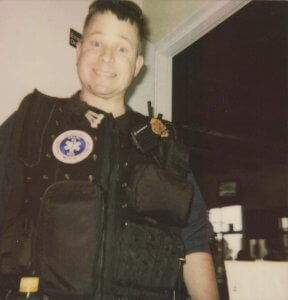
As a federal agent, every time I flew domestically from 1996 to 2017, I was armed, a de facto Air Marshal. Most of our flying armed training had to do with security procedures and jurisdiction, but I did receive specific tactical training–using Simunition FX marking cartridges, in reality based, role playing scenarios onboard grounded commercial aircraft–for how to dominate and secure the tubular passenger cabin.
I was a certified Firearms, Use of Force, Defensive Tactics (empty hands), and CQC (close quarters clearing) instructor for my agencies. I was trained–and trained other special agents–on how to take down (storm or secure) tubular targets like buses and aircraft. Passenger trains are also tubular targets, although I did not specifically train to take down trains; don’t you just love homophones?
To maintain my DoJ firearms instructor certification, I was required to get training from at least one “outside agency” annually to prevent training incest (a stagnation of methods from always training the same way with the same people). Two of those years we trained with a company called GPS. Several of the GPS instructors were former (or current) FBI HRT operators.
With GPS, we spent a great deal of time working on bus takedowns, because our agency’s equivalent of US Marshals, today called Enforcement and Removal Operations or ERO, shuttled detainees from facility to facility or to the border or the airport in what were essentially prison buses. One of our concerns was a detainee uprising resulting in one or more ERO officers being taken hostage on a bus.
Prison buses pose some unique challenges. The windows tend to be covered with steel mesh, preventing rescuers on ladders from breaking and raking. The emergency exits have locking devices. Even inside the bus, entry into the caged area is narrow. As with the tunnel junction to the ICBM LCCs, we would have been forced to enter that very narrow fatal funnel without any flanking support or much ability to maneuver laterally.
While I was a firearms instructor for HSI, I had some brief communications with Paul Castle, progenitor of Center Axis Relock (CAR), a method of operating firearms almost purpose-built for clearing the close quarters seating rows of buses, trains, and aircraft. Castle was a British detective who had to deal with double decker buses, something I never had to. Before he died, Paul sent me copies of his CAR Student and “Train the Trainer” Instructor manuals.
The primary focus of most federal law enforcement agencies, particularly ours, in the wake of 9/11, was terrorism. We were rolled into what became DHS, and HSI, specifically for that reason, although for many, our customs (counter drug) and immigration duties continued as before. I spent most of my time on a National Security group.
As an FBI JTTF Taskforce Officer, I was assigned to a Domestic Terrorism squad, and sometimes farmed out (as the local HSI lackey) to the Foreign Terrorism squad. We trained and worked as investigators, not operators, but I was exposed to various terrorist and counter-terrorist TTPS. I’m a graduate of the FBI CTIOps (Counterterrorism Investigations and Operations, pronounced “city ops”) course.
As mentioned in Appendix I, I practiced the Simultaneous Shot method of dispatching multiple Tangos at Thunder Ranch. Our instructors may have been some of the same people who trained the Navy SEALs who rescued Captain Phillips from Somali pirates with simultaneous shots.
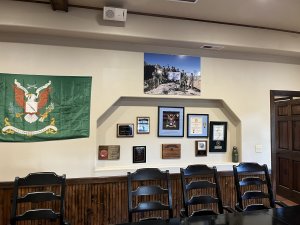
I’m also a graduate of the Arizona POST (Peace Officer Standards and Training) Patrol Rifle Instructor course, HSI M-4 Instructor certification, USAF Combat Arms (small arms) instructor school, and numerous rifle operator courses, including Clint Smith’s Urban Rifle, Jeff Gonzales’ (Trident Concepts) Combative Carbine, and Giles Stock’s Police Carbine Operator course.
My favorite quote thus far from Taylor Sheridan’s Lioness is
“He takes one Pistol course at Thunder Ranch, and he thinks he’s an operator.”
I was a rifleman by trade for much of my adult life. I was never a “sniper,” but I have covered both undercover meets and the approach of arrest teams with a rifle from a distance.
When I was a rookie street cop, we entered a house and were talking with a suspect. I was standing facing him, 90 degrees off from my partner, like they taught us at the academy. It was nighttime, and my back was to a large picture window. Another officer got on the radio, asking me to move right or left a bit. Turned out he was in the yard, keeping the bad guy covered with a rifle.
As you can see, I am truly a swell guy, but take anything you read on the internet–even from me–with a grain of salt. Think about what would make sense for you, and train appropriately, so that if Death ever comes hunting for the kids on your bus, you don’t give him anything for free.
Thanks for caring enough to read all of this.
–George H, lead instructor, Heloderm LLC
